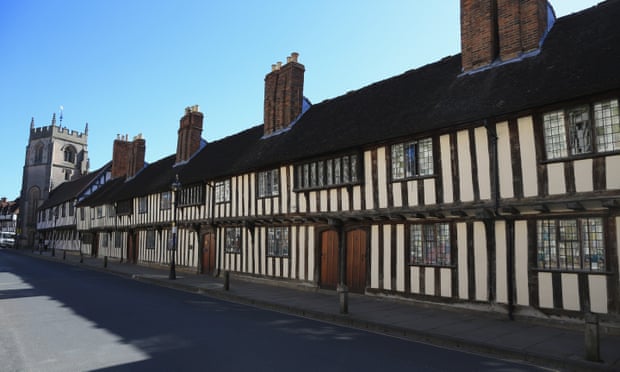The school room in Stratford-upon-Avon where Shakespeare learned “small Latin and less Greek” – as affectionately mocked by his friend Ben Jonson – will open its doors, scarred by centuries of rowdy schoolboys, as part of the town’s commemoration of the 400th anniversary of the death of its most famous son.
“We’re not opening a museum,” said Bennet Carr, head of the King Edward VI school, which will continue to use the building, “we’re welcoming visitors into our world.”
The children and teachers are well used to the tourists pressing their noses and camera lenses beseechingly against the diamond paned windows. From this weekend, after a £1.8m restoration mainly funded by the Heritage Lottery Fund, the tourists will be welcomed in and offered the chance to sit though a Tudor grammar school lesson – but only after 11am on school days. The early mornings will still be reserved for school assemblies and classes, though the pupils will now sit on new benches made of oak from a Warwickshire woods once owned by Shakespeare’s family.
The historian Michael Wood has called it a treasure, “one of the most atmospheric, magical and important buildings in the whole of Britain”.
“Even though the evidence suggests he was yanked out of school without finishing the curriculum, due to his father’s dire business troubles, what he learned here stayed with him for life,” Wood said. “Right through to his last plays he was still drawing on stories he knew and phrases he had translated and learned by rote so many years earlier.”
Performance guide Sam Lesser gives a tutorial in Latin to pupils of King Edward VI School
Facebook Twitter Pinterest
Performance guide Sam Lesser gives a tutorial in Latin to pupils of King Edward VI School Photograph: Christopher Furlong/Getty Images
The project manager Lincoln Clarke said the school’s importance for Shakespeare was incalculable. “The birthplace is obviously key, because that’s where he happened to be born, but this is the building that made him Shakespeare, where he learned so much, witnessed so much, that inspired him for the rest of his life. It is of worldwide significance.”
The school was venerable even in Shakespeare’s day, and the building much older: dendrochronology work during the restoration has dated the earliest timbers to 1420. “We bear his name but we don’t regard Edward VI as our founder,” Carr said. “He stole the school when he abolished its true founder, the Guild of the Holy Cross – but at least he had the sense not to abolish the school.”
The stories you need to read, in one handy email
Read more
Fundraising continues, partly as a result of the dramatic reappearance of John the Baptist. It was known that the building had ancient wall paintings, including the earliest Tudor roses in England, which the town – which had sided with the Yorkists – clearly thought it politic to add when the regime changed.
A whole painted wall emerged in the conservation work, including faint but still recognisable images of the Virgin Mary and the Trinity, probably deliberately defaced and covered over in the Reformation, possibly by Shakespeare’s own father during his term as mayor.
Then a few months ago, after an image reconstructing the original appearance of the original painting had been completed, an unexpected and startlingly well-preserved painting of the John the Baptist emerged on a beam, holding a lamb, still with traces of gilding on his staff.
Advertisement
“His face and his blazing eyes were uncovered first - it was a transfixing moment,” Carr recalled.
Among the genuine treasures the visitors will see, one outrageous fake has been kept: a little pane of glass into which somebody – almost certainly a schoolboy – has scored “William Shakespeare 1575”. Of the six known genuine signatures of Shakespeare, all are different and not one spells his name in the way now regarded as correct.
“We’re expecting around 100,000 visitors a year,” said Carr, who lives a few yards from the schoolroom, on the other side of an absurdly picturesque courtyard. “So that could be 100,000 pairs of eyes peering in at me eating my cornflakes. I’m OK with that, it comes with the job, but I’m not sure the scale of it has entirely dawned on my wife yet.”
Electricians, carpenters and painters are still working flat out this week. The admission on Saturday will be free. “It’s our gift to the town,” Clarke said, “and also our get-out-of-jail-free card in case we’re not absolutely completely 100% finished.”
• Shakespeare’s Schoolroom and Guildha
Source by : http://www.theguardian.com/culture/2016/apr/20/shakespeares-school-to-open-to-visitors-to-celebrate-400th-anniversary
 10:38 AM
10:38 AM
 Unknown
Unknown


 Posted in:
Posted in: 

0 comments:
Post a Comment